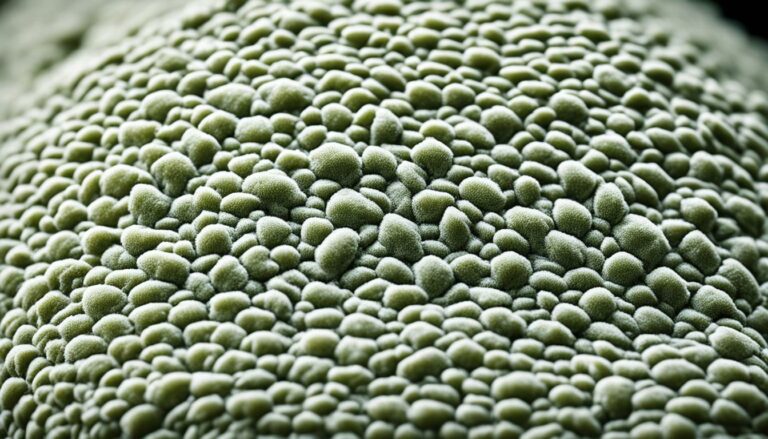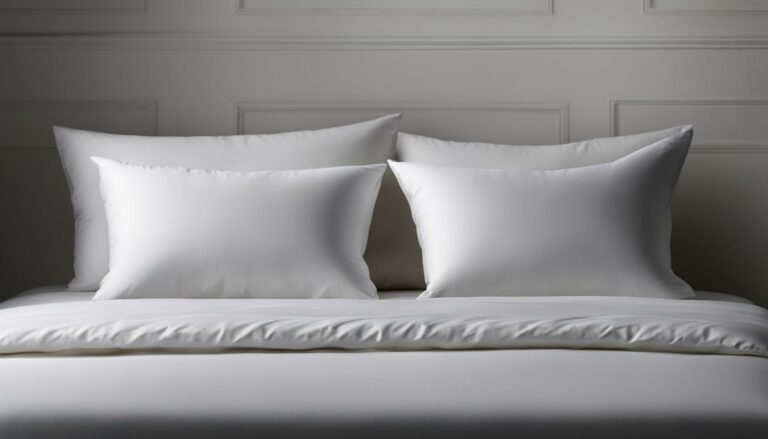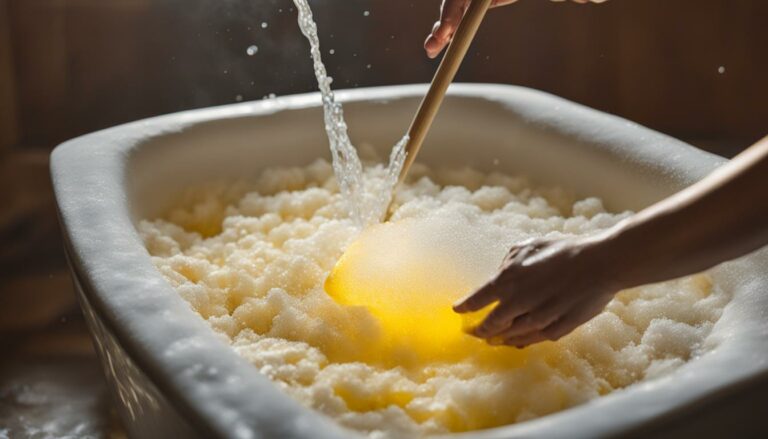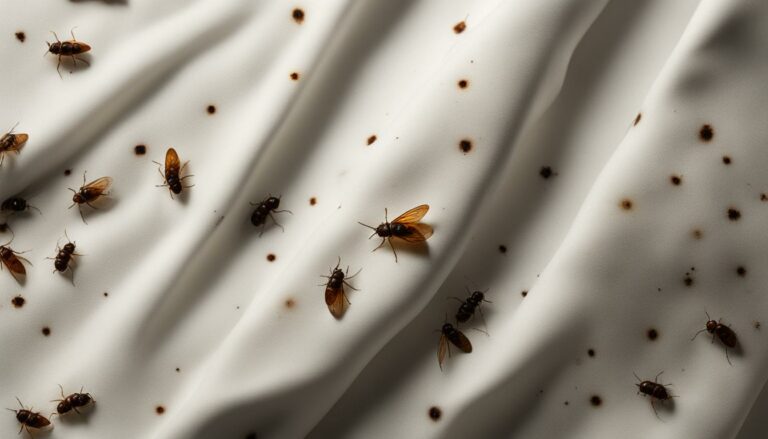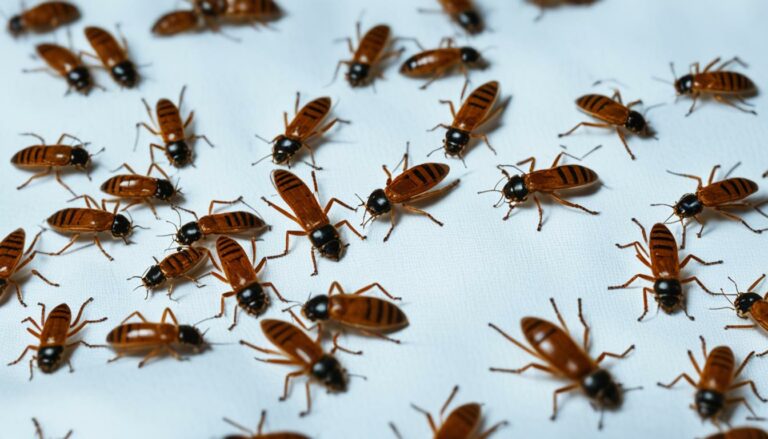Yellow Drool Stains on Pillow? Remove Them Now!
Eric Christie stands as a luminary in the bedding industry, with a career spanning nearly four decades since the early 1980s. His journey through the world of bedding has seen him wear many hats – a manufacturer, designer, and retailer, showcasing his versatility and expertise in Read more...
pillowsandbedsheets.com and its partners may earn a commission if you purchase a product through one of our links
Do you struggle with pesky yellow drool stains on your pillows? Don’t worry, you’re not alone. Pillow stains can be frustrating and unsightly, but the good news is that there are effective ways to remove them and restore your pillows to their former glory.
In this article, we will explore why pillows turn yellow, whether it’s safe to sleep on stained pillows, and most importantly, how to remove those stubborn yellow drool stains. So, get ready to bid farewell to those unsightly pillow stains and say hello to fresh, clean pillows!
Key Takeaways:
- Pillows can turn yellow due to moisture and the breakdown of urea in sweat, which turns into ammonia over time.
- Using pillow protectors and regular washing can prevent yellowing and stains.
- Pillows with yellow spots are generally safe to use, but it’s recommended to replace them if they are old, misshapen, or have a musty smell.
- To remove yellow stains from pillows, pre-treat with a stain remover and soak in a solution of oxygen bleach and water before laundering.
- Different types of pillows require different cleaning methods, so follow care label instructions for best results.
Why do pillows turn yellow?
Pillows can be cozy companions for a restful night’s sleep, but over time, you may notice unsightly yellow stains on them. These stains can be quite frustrating, especially when they seem to appear out of nowhere. But fear not, there’s a scientific explanation behind this common phenomenon.
The yellowing of pillows is often caused by a combination of moisture and various substances that come into contact with them, such as sweat, face lotions, drool, and skin/hair oils. When these substances interact with the fabric of the pillow, they can leave behind yellow stains. Even something as innocent as wet hair before bedtime can contribute to the formation of these pesky stains.
The primary culprit responsible for the yellowing of pillows is urea, which is found in sweat. Urea naturally breaks down over time, converting into ammonia. It is this chemical reaction that causes the yellow coloration on pillows.
If you’re dealing with yellow stains on your pillow, it’s essential to address them promptly. Not only can these stains be unattractive, but they can also harbor bacteria and allergens, impacting your sleep environment. In the next section, we’ll explore effective methods for removing drool stains and restoring your pillows to their former glory.
Is it safe to use pillows with yellow spots for sleeping?
Using pillows with yellow spots is generally safe, but there are certain circumstances where it may be best to replace them. If your pillows are old, misshapen, or have a musty smell, it’s time for a replacement. These factors can indicate that the pillows are no longer providing proper support or have accumulated dirt and bacteria over time.
If your pillows only have yellow spots but are otherwise in good condition, you can take steps to remove the stains and ensure a clean and comfortable sleep. One effective method is to use pillow protectors, which act as a barrier between your pillow and any potential stains. These protectors can be easily removed and washed, preventing drool stains on pillows and maintaining their freshness.
Pillow protectors are especially beneficial if you tend to drool during sleep or if you have children who may accidentally leave drool stains on the pillows. By using protectors, you can keep your pillows looking clean and extend their lifespan.
For an added layer of protection and cleanliness, it’s recommended to wash your pillows regularly. This can help remove any sweat, oils, or other substances that may contribute to yellowing. Different types of pillows may require specific care instructions, so be sure to consult the manufacturer’s guidelines for the best washing method.
Overall, while it is generally safe to use pillows with yellow spots, it’s essential to consider their overall condition and take steps to prevent or clean drool stains on pillows. By replacing old or damaged pillows, using pillow protectors, and practicing regular pillow maintenance, you can ensure a hygienic and comfortable sleep environment.
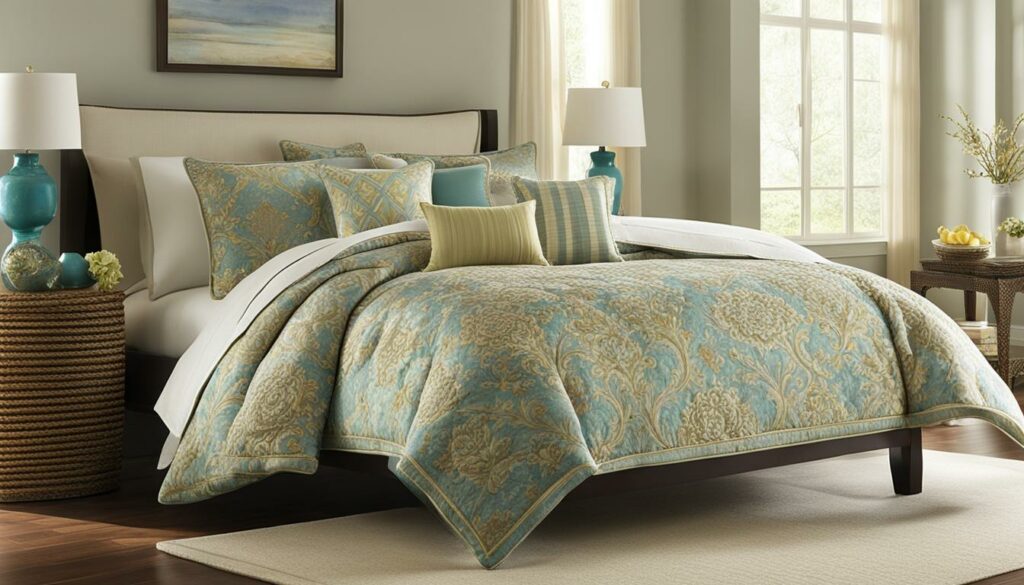
Additional Tips:
- Spot clean any fresh stains on your pillows immediately to prevent further discoloration.
- Consider using pillowcases made from materials that are less likely to absorb drool stains, such as satin or silk.
- Avoid exposing your pillows to direct sunlight, as this can cause fading and yellowing.
- Replace your pillows every 1 to 2 years for optimal comfort and hygiene.
“Using pillow protectors and regularly washing your pillows can help prevent yellowing and maintain their cleanliness.” – Zachary Pozniak, Cleaning Influencer
How to Prevent Yellow Stains on Pillows
To keep your pillows looking fresh and free from yellow stains, there are a few simple steps you can take. By using pillow protectors, regularly washing your pillows, and spot cleaning spills and stains, you can maintain the appearance of your pillows and prevent drool stains effectively.
1. Use Pillow Protectors
Pillow protectors are a great investment to prevent yellow stains on your pillows. They act as a barrier between your pillow and any potential stains, such as drool or spills. Look for pillow protectors that zip over the entire pillow, providing complete coverage. Not only do these protectors keep stains at bay, but they also help to extend the lifespan of your pillows.
2. Regularly Wash Your Pillows
Regular washing is essential to keep your pillows clean and stain-free. Be sure to check the care instructions for your specific pillow type, as different materials may require different washing methods. In general, most pillows can be washed in a machine on a gentle cycle. However, foam pillows should be spot cleaned instead of being machine-washed. Follow the recommended washing frequency for your pillows to maintain their freshness and prevent yellowing.
3. Spot Clean Spills and Stains
Accidents happen, and spills or stains on pillows are inevitable. To prevent these stains from setting in and causing yellowing, it’s important to spot clean them as soon as possible. Use a mild detergent and a clean cloth or sponge to gently blot the stain. Avoid rubbing the stain, as it can spread and make it harder to remove. Once the spot has been cleaned, allow it to air dry before using the pillow again.
Did You Know? Using pillow protectors and spot cleaning spills can help prevent the need for frequent washing, extending the life of your pillows.
By following these simple tips, you can prevent yellow stains on your pillows and ensure they stay fresh and clean for a long time. Remember to regularly check and clean your pillows to maintain their appearance and hygiene.
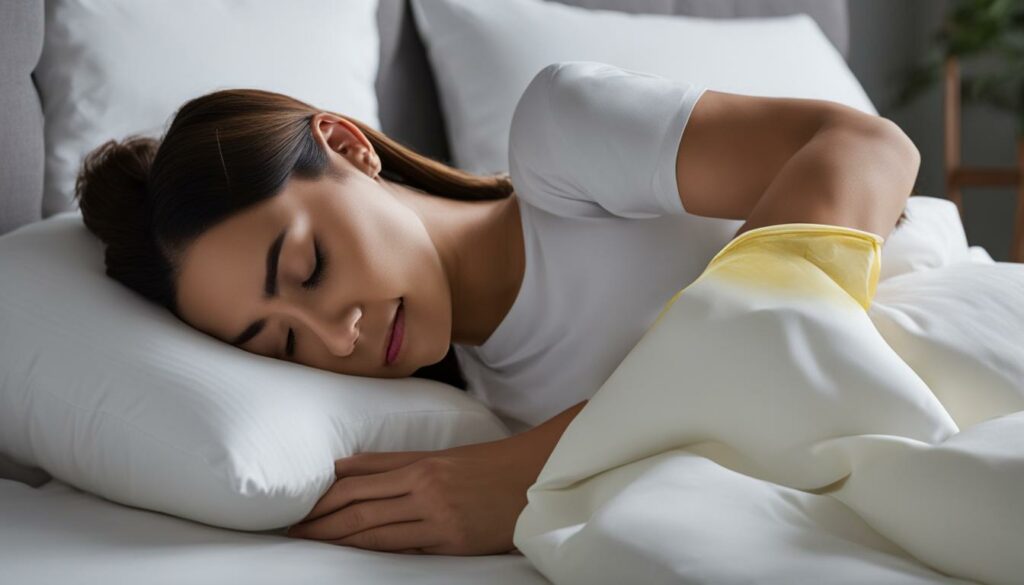
| Pillow Care Tips |
|---|
| Use pillow protectors to prevent stains |
| Regularly wash your pillows |
| Spot clean spills and stains |
How to Remove Yellow Stains from Pillows
Yellow stains on pillows can be unsightly and difficult to remove. Luckily, with the right techniques and products, you can effectively clean drool stains on pillows and restore them to their original condition. Follow these steps to remove yellow stains from your pillows:
- Pre-treat yellow stains on pillowcases and sheets with a stain remover. Apply the stain remover directly to the stained area and gently rub it in. Let it sit for a few minutes to penetrate the fabric.
- Prepare a solution of oxygen bleach and water. Oxygen bleach, such as hydrogen peroxide, is effective at breaking down tough stains without causing discoloration. Use a ratio of 1 part oxygen bleach to 6 parts water.
- Submerge the pillow in the oxygen bleach solution. Ensure that the entire pillow is fully soaked. You can use a bathtub, large sink, or basin for this step. Leave the pillow to soak overnight to allow the bleach to work on the stains.
- Launder the pillow in lukewarm water on a gentle cycle. Use a mild detergent that is suitable for the fabric of your pillow. Avoid using harsh chemicals or bleach, as they can damage the pillow fibers.
- After the wash cycle is complete, check the pillow for any remaining stains. If there are still visible stains, repeat the pre-treatment and soak steps until the stains are fully removed.
- Once the stains are gone, air-dry the pillow thoroughly. Placing it in direct sunlight can help eliminate any lingering odors. Ensure the pillow is completely dry before using it again.
- If you are unsure about how to treat specific stains on your pillow, it’s always a good idea to consult a professional dry cleaner. They can provide expert advice and recommend appropriate stain removal techniques.
By following these steps, you can effectively clean drool stains on pillows and prolong their lifespan. Regular maintenance, such as using pillow protectors and washing pillowcases, can also help prevent the formation of yellow stains in the future.
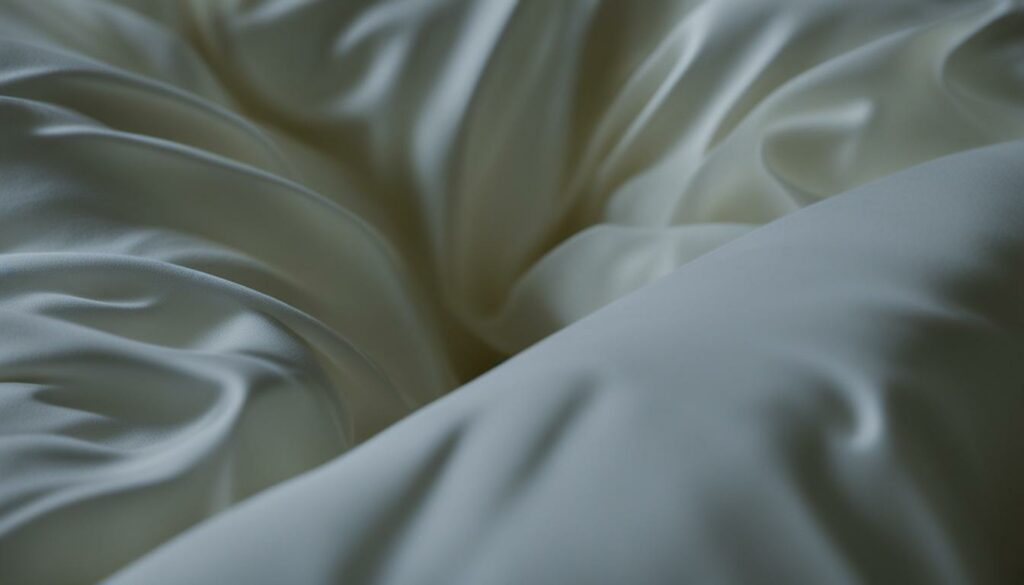
Remember, taking proper care of your pillows not only keeps them looking clean and fresh but also ensures a comfortable and hygienic sleep experience.
How to Wash Down and Fibrefill Pillows
Keeping your down and fibrefill pillows clean is essential for a comfortable and healthy sleep. Over time, these pillows can accumulate dirt, oils, and allergens, affecting their appearance and performance. Fortunately, washing down and fibrefill pillows is a simple process that can help restore their freshness and extend their lifespan.
Machine-Washing Down and Fibrefill Pillows
Most down and fibrefill pillows can be safely washed in a machine, ensuring a thorough and efficient cleaning process. Follow these steps to wash your pillows:
- Check the care label: Before starting, always check the care label attached to your pillow. It provides specific instructions on how to clean and care for your particular type of pillow. Follow the manufacturer’s recommendations for the best results.
- Pre-treat stains: If your pillows have any visible stains, pre-treat them by gently dabbing the affected area with a mild stain remover or laundry detergent.
- Load the machine: Place up to two pillows in your washing machine to maintain balance during the wash cycle. Adding a few towels or a clean tennis ball can help prevent the pillows from clumping or losing their shape.
- Use a gentle cycle: Set your washing machine to a gentle or delicate cycle with an extra cold rinse. Using warm water may shrink or damage your pillows.
- Select a mild detergent: Use a mild liquid detergent, preferably one that is free of bleach and harsh chemicals. This will help protect the pillow’s filling and maintain its loft.
- Extra rinse: Opt for an extra rinse cycle to ensure that all detergent residue is removed from the pillows. This step is crucial for preventing any potential irritation or sensitivities.
- Drying process: Place the pillows in your dryer and set it to a low heat or air fluff setting. Add a couple of clean tennis balls or dryer balls to help fluff the pillows during the drying process. Dry the pillows thoroughly to avoid the growth of mold or mildew.
Remember to fluff your pillows frequently during the drying process to prevent clumping and ensure even distribution of the filling. Remove the pillows from the dryer once they are completely dry and ready for use.
Individual Care Label Instructions
While the general washing instructions provided above work for most down and fibrefill pillows, it’s important to note that some pillows may have specific requirements. Always refer to the care label attached to your pillow for the manufacturer’s recommended cleaning instructions to achieve the best results.
How to Wash Foam Pillows
If you have foam pillows, such as memory foam, it’s important to know that they should not be washed in the machine. Foam can retain water and take a long time to dry, which can lead to mold or damage to the pillow. But don’t worry, there are alternative methods to keep your foam pillows clean and fresh.
Follow these easy steps to wash foam pillows:
- Vacuum the pillows: Start by using a vacuum cleaner with a brush attachment to remove any dust, dirt, and debris from both sides of the pillow. This will help keep your pillows clean and hygienic.
- Spot clean soiled areas: If you notice any stains or spills on your foam pillows, it’s best to spot clean them. Use a mild soap or detergent, mixed with water, and apply it directly to the soiled areas. Gently blot the stain with a clean cloth or sponge until it lifts.
- Air drying: After spot cleaning, allow the pillow to air dry completely before using it again. Avoid placing it in direct sunlight or using heat sources such as a hairdryer, as they can damage the foam material.
Remember, foam pillows should not be submerged in water or machine-washed. The spot cleaning method allows you to target specific areas without compromising the pillow’s integrity.
To give you a better visual understanding, here’s a comparison table outlining the do’s and don’ts of washing foam pillows:
| Do’s | Don’ts |
|---|---|
| ✅ Vacuum both sides of the pillow | ❌ Machine wash |
| ✅ Spot clean soiled areas with mild soap | ❌ Submerge in water |
| ✅ Allow the pillow to air dry | ❌ Use direct heat sources (e.g., hairdryer) |
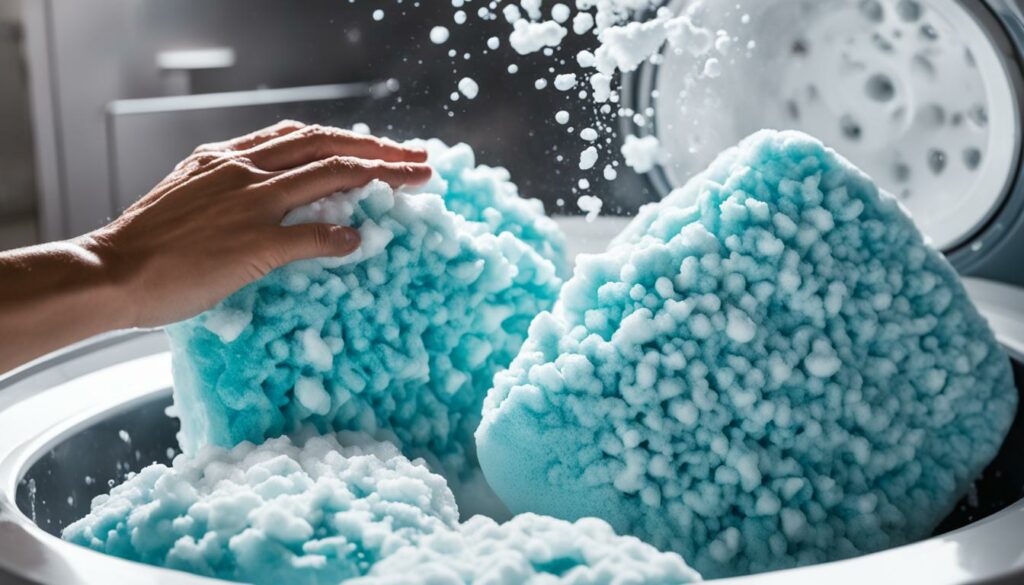
Avoiding machine washing and following these proper cleaning techniques will help maintain the quality and prolong the lifespan of your foam pillows. By keeping them clean, you can enjoy a comfortable and restful night’s sleep, free from any dirt or allergens.
Can you get yellow stains out of pillows?
Yes, yellow stains can be removed from pillows with the right approach and products. However, it is important to avoid using chlorine bleach as it can cause further yellowing and damage to your pillows. Instead, opt for oxygen bleach solutions that are safe and effective in removing yellow stains.
One common and reliable oxygen bleach solution for cleaning yellow stains on pillows is a mixture of hydrogen peroxide and sodium carbonate. Together, these ingredients work to break down the stain and restore the pillow’s original color.
“Oxygen bleach is a safe and effective alternative to chlorine bleach for removing yellow stains from pillows.”
To effectively remove yellow stains from your pillows, follow these steps:
- Remove the pillowcase and pillow protector, if applicable.
- Inspect the pillow for any specific stain areas and treat them with a pre-wash stain remover.
- In a basin or sink, create a solution by mixing hydrogen peroxide and sodium carbonate according to the product instructions.
- Place the pillow in the solution and let it soak for several hours or overnight, allowing the oxygen bleach to break down and lift the yellow stains.
- After the soaking period, gently squeeze out excess water from the pillow.
- Wash the pillow in the washing machine on a gentle cycle with mild detergent. This will help to further clean the pillow and remove any remaining yellow stains.
- Once the washing cycle is complete, remove the pillow from the machine and gently reshape it if needed.
- Allow the pillow to air dry completely before putting the pillowcase and protector back on.
Comparison of Cleaning Solutions for Yellow Stains
| Cleaning Solution | Effectiveness | Safety |
|---|---|---|
| Oxygen bleach (hydrogen peroxide and sodium carbonate) | High | Safe |
| Chlorine bleach | Moderate | Potential for further yellowing and damage |
By using oxygen bleach solutions like hydrogen peroxide and sodium carbonate, you can effectively remove yellow stains from your pillows while keeping them clean and fresh. Remember to always follow the product instructions and take proper care of your pillows to prevent future yellowing.
How to Launder and Dry Pillows Properly
Properly washing and drying your pillows is essential for maintaining their cleanliness and longevity. Whether you have polyester, down, or feather pillows, a few simple steps can help you achieve the best results.
Machine-washing Polyester, Down, and Feather Pillows
The most effective method for washing polyester, down, and feather pillows is using a washing machine. Follow these steps to ensure a thorough and gentle cleaning:
- Remove the pillowcases and covers from the pillows.
- Check the care label for any specific instructions or limitations.
- Place two pillows in the washing machine to maintain balance.
- Add a mild detergent suitable for delicate fabrics.
- Include a whitening solution, such as hydrogen peroxide or sodium carbonate, to brighten and remove stains.
- Set the washing machine to a gentle cycle with cold water.
- Start the washing machine and allow it to complete the cycle.
- Remove the pillows from the washing machine and squeeze out excess water. Avoid twisting or wringing the pillows.
- Dry the pillows thoroughly to prevent mildew and ensure their fluffiness.
Drying Polyester, Down, and Feather Pillows
The drying process for different types of pillows may vary. Here’s how to properly dry polyester pillows and air-dry down and feather pillows:
Tip: To ensure optimal drying and avoid clumping or misshapen pillows, it’s recommended to dry pillows individually.
1. Drying Polyester Pillows:
| Pillow Type | Drying Method |
|---|---|
| Polyester | Machine dry on a medium heat setting |
2. Air-Drying Down and Feather Pillows:
| Pillow Type | Drying Method |
|---|---|
| Down | Air-dry flat or hang outdoors in a shaded area |
| Feather | Air-dry flat or hang outdoors in a shaded area |
After drying, fluff the pillows by hand or with a gentle shake to distribute the filling evenly. Ensure the pillows are completely dry before placing them back on your bed for a comfortable night’s sleep.
How to Hand-Wash Pillows to Remove Yellow Stains
While most pillows can be safely machine-washed, some delicate or specialty pillows require hand-washing to remove stubborn yellow stains. Follow these steps to effectively hand-wash your pillows and restore their cleanliness:
- Pre-treat stains: Before washing your pillows, pre-treat any noticeable yellow stains with a laundry pre-treater. Apply the pre-treater directly to the stained areas and gently rub it in.
- Create a cleaning solution: Fill a basin or sink with hot water. Add a small amount of mild laundry detergent to create a soapy solution. Mix the water and detergent until well combined.
- Scrub the stain: Place the pillow in the soapy water and gently scrub the stained areas using a soft brush or cloth. Be careful not to be too rough and damage the pillow’s material. Pay extra attention to the yellow drool stains, ensuring thorough cleaning.
- Rinse: Once you’ve scrubbed the stains, thoroughly rinse the pillow with detergent-free water. Make sure to remove all the soap residue to prevent it from attracting more dirt.
- Air-dry or pat-dry: After rinsing, squeeze out excess water from the pillow without wringing it. You can either air-dry the pillow by laying it flat on a clean, dry surface or gently pat it with a clean towel to remove excess moisture.
Follow the care instructions provided by the pillow manufacturer for the best results. Some pillows may require additional steps or precautions, so it’s essential to always refer to the specific guidelines.
Hand-washing your pillows allows for targeted stain removal and gentle cleaning, making them fresh and ready for use. Remember to regularly clean your pillows to maintain their hygiene and extend their lifespan.
How to Keep Pillows White
When it comes to maintaining clean and fresh pillows, proper pillow care and maintenance are essential. Here are some tips to help you keep your pillows white and in the best condition possible.
First, consider using a quilted pillow protector. These protectors create an additional layer between your pillow and pillowcase, helping to prevent stains and yellowing. Choose pillow protectors made from materials like cotton or polyester that are breathable and machine washable.
In addition to using a pillow protector, opting for pillowcases made from less absorbent fabrics can contribute to keeping your pillows white. Satin or silk pillowcases, for example, are less likely to absorb oils and sweat, which can cause discoloration over time.
Regular washing is another crucial aspect of pillow care. Aim to wash your pillows at least twice a year, or more frequently if necessary. Follow the care instructions provided by the manufacturer, as different types of pillows require specific care. Generally, machine washing on a gentle cycle with mild detergent is suitable for most pillows. Remember to thoroughly dry your pillows before using them again, as dampness can lead to unpleasant odors or mold.
FAQ
Yellow Drool Stains on Pillow? Remove Them Now!
Cleaning influencer Zachary Pozniak shares a routine on TikTok to clean yellow drool stains on pillows. He uses dish soap, water, and hydrogen peroxide to remove oils and restore the color. Pillow protectors and regular washing can prevent yellowing.
Why do pillows turn yellow?
Pillows can turn yellow due to moisture, such as sweat, face lotions, drool, and skin/hair oils. Wet hair before bed can also contribute to yellow stains. The yellowing is caused by the breakdown of urea in sweat, which turns into ammonia over time.
Is it safe to use pillows with yellow spots for sleeping?
While using pillows with yellow spots is generally safe, it is recommended to replace them if they are old, misshapen, or have a musty smell. Pillow protectors can prevent yellowing and stains, ensuring a clean and comfortable sleep.
How to prevent yellow stains on pillows
Using pillow protectors that zip over the pillow and regular washing can prevent yellow stains. Spot cleaning spills and stains can also help maintain the pillow’s appearance. Different types of pillows may require different washing frequencies.
How to remove yellow stains from pillows
Pre-treat yellow stains on pillowcases and sheets with a stain remover. Use a solution of oxygen bleach and water to soak the pillow overnight. Launder the pillow in lukewarm water on a gentle cycle. Consult a professional dry cleaner for advice on specific stains.
How to wash down and fibrefill pillows
Down and fibrefill pillows can be washed in the machine on a gentle cycle with an extra cold rinse. Fluff the pillows frequently during the drying process to prevent lumpiness. Follow individual care label instructions for best results.
How to wash foam pillows
Foam pillows, including memory foam, should not be washed in the machine. Instead, vacuum both sides of the pillow to remove dust, and spot clean soiled areas with mild soap and a cloth. Allow the pillow to air dry before using it again.
Can you get yellow stains out of pillows?
Yes, yellow stains can be removed from pillows. It is important to avoid using chlorine bleach, as it can cause further yellowing. Oxygen bleach, such as hydrogen peroxide and sodium carbonate, is safe for removing yellow stains from pillows.
How to launder and dry pillows properly
The best way to wash polyester, down, and feather pillows is in the washing machine with cold water, mild detergent, and a whitening solution. Dry polyester pillows on medium heat and air-dry down pillows. Foam, gel, and cooling pillows should not be machine-washed.
How to hand-wash pillows to remove yellow stains
For pillows that cannot be machine-washed, pre-treat stains with a laundry pre-treater. Create a solution of hot water and mild laundry detergent and scrub the stain gently. Rinse with detergent-free water and air-dry or pat-dry with a towel.
How to keep pillows white
Using a quilted pillow protector and choosing pillowcases made from less absorbent fabrics, such as satin or silk, can help keep pillows white. Regular washing, at least twice a year or as needed, is also important to maintain clean and fresh pillows.
Eric Christie stands as a luminary in the bedding industry, with a career spanning nearly four decades since the early 1980s. His journey through the world of bedding has seen him wear many hats – a manufacturer, designer, and retailer, showcasing his versatility and expertise in Read more...



